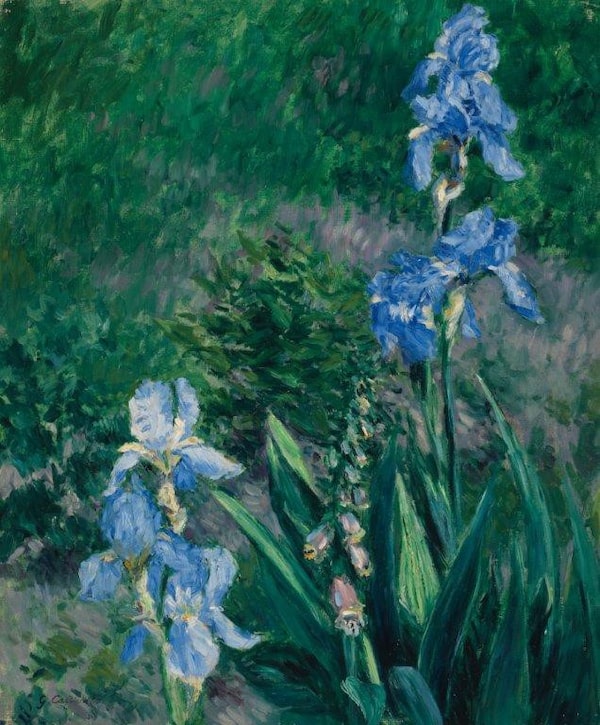The French irises are here to stay: After three years of delays and disputes, the Art Gallery of Ontario has acquired Iris Bleus, Jardin du Petit Gennevilliers by Gustave Caillebotte for a price tag of more than $1-million. The prized French Impressionist painting from 1892 was at the centre of a recent fight over export permits for significant works, after it was sold to a British art dealer at a Toronto auction in 2016 but blocked from leaving the country.
Under a system designed to help keep such works in Canada, the AGO is receiving a $540,000 grant from the federal government toward the purchase. AGO chief curator Julian Cox would not disclose the full price, but said the grant covered slightly less than 50 per cent. A $1-million-plus figure would represent a significant profit for the unnamed British seller, who paid $678,500 in 2016. However, Cox said the painting marks an important addition to the AGO’s collection and is the only example of Caillebotte’s rare, but increasingly prized work in a large Canadian museum.

The 1892 Gustav Caillebotte painting Iris bleus, jardin du Petit Gennevilliers.�/The Canadian Press
“It does so many things for us in terms of the story of 19th-century art: It expands the discussion around Impressionism in particular,” Cox said of the work by an artist who both supported the Impressionists and painted with them. “Caillebotte funded the Impressionism exhibitions of the era; he was independently wealthy. He was a peer, but a patron too.”
The painting, which shows stems of pale blue irises against a backdrop of greenery in the artist’s suburban garden, will go on public display at the AGO on Saturday. It was executed two years before the artist’s premature death at the age of 45, during a period when he was working closely with Claude Monet who was also painting flowers, in his famed garden at Giverny. The one other notable example of a Caillebotte in Canada is a scene of sailboats on the Seine dating to 1883 that belongs to the McMaster Art Gallery at McMaster University in Hamilton.
Caillebotte, known for a crisper style that his Impressionist contemporaries, often painted intense, highly realistic city scenes before he moved to Gennevilliers, outside of Paris. There, his work became looser and, like Monet’s, began to foreshadow the development of abstraction, Cox said. His art is increasingly sought after by museums: Cox pointed to recent acquisitions of other garden paintings by New York’s Metropolitan Museum and the National Gallery of Art in Washington, D.C.
Iris Bleus was originally purchased by the British dealer at a sale held by the Heffel Fine Art Auction House in November, 2016, but the Canadian Cultural Property Export Review Board (CCPERB) judged it too significant to leave Canada and subjected it to an export delay. The AGO has been negotiating to buy it ever since, but the British buyer refused a first offer, leading to a stalemate.
CCPERB can delay the departure of art considered of “outstanding significance and national importance,” but the rules do not define what that means and whether it can be applied to both foreign and Canada art. That issue was at the crux of a legal battle over the Caillebotte launched when Heffel sued the federal government, arguing the interpretation of national importance was far too broad.
At first, a federal court agreed: In a 2018 decision, Judge Michael Mason argued that foreign art could not be considered central to Canadian cultural heritage, sending the museum world into a tailspin. Purchases such as the one the AGO is now unveiling – using both the government grant and funds from two private bequests from the estates R. Fraser Elliott Estate and F.W.G. Fitzgerald – are rare: The Caillebotte was one of only seven objects delayed that year and sometimes no museum comes forward to purchase blocked items. However, in a parallel system, the same criteria of outstanding significance and national importance are used by CCPERB to decide whether art that collectors want to donate qualifies for special tax credits, enabling Canadian museums to acquire much of their art.
Fearing that these incentives for donations had been sideswiped by the judge’s decision, museums across the country joined the federal government in a successful appeal – but not before Ottawa had also removed the words “national importance” from the rule book in the 2019 budget. The appeal judge ruled that is up to CCPERB experts to rule on art’s importance.
With those moves, the system has reverted to one in which collectors can still count on tax credits for donated art, while the exceptional export delay may give museums opportunities to buy works as rare as the painting of blue irises.
 Kate Taylor
Kate Taylor